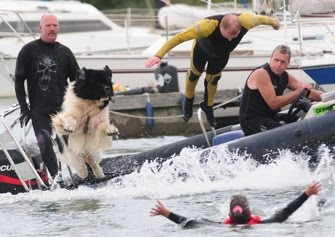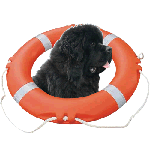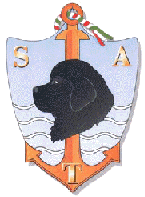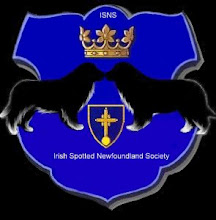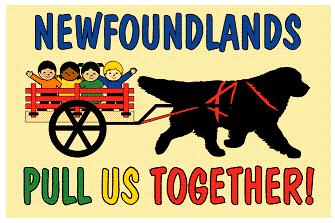
(Mary Anderson, Redwood Times, Garberville, CA 9/23/2009)
His name is Turk. He’s a seven-month old Newfoundland puppy and his purpose in life is to save Ruth Ann Goodfield’s life.
Ruth Ann has epileptic seizures. Her condition was diagnosed in first grade. Her teacher at the time, Claire Piccinelli, noticed that Ruth Ann was having “absent” seizures in class. Piccinelli recommended that Ruth Ann be evaluated by an endocrinologist and Ruth Ann’s mother, Susan, did that.
”Immediately when we walked into the office", Susan says, “they said that she had had a stroke. There were complications in her birth and they think that’s when she had the stroke. They assume that it was the stroke that caused the epilepsy.”
Ruth Ann continued to have absent seizures until recently. With the onset of puberty, she began to have grand mal seizures.
”Puberty often strengthens the seizures and that’s what happened with her", Susan says. “She went into grand mal seizures and still has absent seizures as well. We didn’t put her on medicine right away, but she has really long seizures. That’s rare. Usually seizures last about three minutes, but her seizures last about eight minutes, which is very dangerous. So we put her on some medication and so far, so good. The medication is holding down the seizures, but that’s also why having a dog is more important for her than for some who have milder seizures. The long seizures bring her close to death each time and the sooner you react to them the better. I can give her emergency medicine to relax her body and help her breathe better.”
During an earlier seizure, Susan says, Ruth Ann wasn’t able to breathe because her muscles were too tight. She hasn’t had a grand mal seizure since she’s been on the medicine, but it’s very important that when a seizure does occur, someone is there to help Ruth Ann through it. That’s going to be Turk’s job. He will know when Ruth Ann is having a seizure and he will alert Susan or whoever is there to it so that Ruth Ann gets her medication and is protected.
Turk is named after the gorilla in the Disney Tarzan movie, and Ruth Ann and Susan first met Turk at Disneyland. He comes from Noelle’s Angel Dogs, and in return for Disney’s sponsorship, Noelle’s Angel Dogs are all named after Disney characters. Noelle’s Angel Dogs are located in Monument, Colorado, and the organization was founded because Noelle also has epilepsy. When Noelle was a child like Ruth Ann, her parents were unable to find a service dog that would alert them to Noelle’s seizures. They made it their business to learn how to train seizure alert dogs and when Noelle turned 18, she founded Angel Dogs to focus on training seizure alert dogs for children.
Susan says that Ruth Ann fell in love with the gangly, loveable pup at first sight but he had already been promised to someone else. That didn’t work out, however, and Turk became available. He has been with Ruth Ann and her family for about a month now, although Ruth Ann feels so comfortable with Turk, she says she feels like she’s known him for a year.
Seizure alert dogs are trained a little differently that other service dogs. ”With seizure dogs", Susan says, “they like the person with epilepsy to do the obedience training. They like them to be trained by the owner so that they will connect more with them and be able to detect the seizures, which is really unique for a service animal.”
Turk came to them with some basic obedience training, she says. His training started when he was six weeks old. ”He’s still going through his obedience training", she says, “and he’ll finish that up, we’re hoping, around June. He’ll go back to Colorado for his detail service training, where he’ll learn to do water rescue, learn how to bring Ruth Ann her medicine, how to find her, how to turn her on her side, push a 9-1-1 button, and find a grownup to help her.”
In the short time he’s been with them, Turk has settled in and become part of the family, which includes Rosie, an older Beagle.
”He’s a puppy and our Beagle is an adult and not as playful, so Rosie has to tell him to leave her alone once in a while. But they get along,” Susan says.
Ruth Ann and Susan started out the training by learning a few key commands and every week they get a new command from Noelle’s. The commands start out as a game and evolve into a service. Susan says, “We’re learning a new game called ‘where’s Ruth Ann,’” Susan says, “and that will eventually be a very big service. Say, she’s in college and has a seizure and he’s off by himself, someone will say ‘where’s Ruth Ann’ and he will bring that person to her. He’s also learning to bring her medicine to her.”
Noelle’s keeps in close contact with Ruth Ann and Susan and drives over from Colorado every other month to check on their progress. Their next visit will be in October, at which time Turk and Ruth Ann will be tested on what they’ve learned. Susan says that the folks from Noelle’s say they are very proud of the way Ruth Ann is taking to Turk and training him. They say she’s doing a great job with the training. Turk knows when Ruth Ann is having a silent seizure and alerts to it so it can be recorded in a diary for Ruth Ann’s endocrinologist.
Turk sleeps in Ruth Ann’s room and they have already bonded. Ruth Ann says Turk has a very playful personality. She expects to be able to take him to school with her in a few weeks. Right now, Turk goes with Susan to her job at South Fork High School so he will get used to a school environment. The South Fork staff and the Redway Elementary staff are very accommodating to the situation.
”The principal and the teachers have been wonderful,” she says. “And when she is prepared to take him to the elementary school, they have already said ‘no problem.’ Everybody in this community has been terrific.”
Ruth Ann is in Dan Brown’s 6th grade class.
Mom says that even though Ruth Ann’s seizures are silent, Turk will know when she is having a seizure and will bark to alert Mom to that. Her seizures are noted in a book that is kept so her doctor will know when and how many seizures she has. He also accompanies her into the shower to alert Mom if Ruth Ann has a seizure while bathing.
Ruth Ann says she can’t remember her seizures and doesn’t know what they feel like.
The biggest problem with a service dog, they say, is getting people accustomed to ignoring the dog and not trying to pet the dog. ”Turk is so adorable, such a beautiful dog, that people want to pet him,” Susan says. “They have to restrain themselves from petting him. He gets tired of it.”
Being a Newfoundland, Turk is a water rescue dog that can swim for as long as three hours. Only polar bears can outswim a Newfoundland, Susan says. He weighs 90 pounds now and will weigh about 160 when he is fully grown. Ruth Ann is very active. She plays soccer, and also goes kayaking and swimming. Now she will have Turk there to help her if she should have a seizure while she’s in the water.
It cost $7,500 to purchase Turk, none of which is covered by insurance. Through the generosity of Ruth Ann’s stepdad, Clay Early, and his fellow workers in the County Road Department, they were able to raise $1,300 for the down payment on the dog. Other donations have come in from the community, but they still owe a little over $4,000 on him. If people want to donate toward Turk’s purchase, make the check out to Noelle’s Angel Dogs, and send it P.O. Box 1627, Redway.
And if you see Turk out and about with Ruth Ann and Susan, they ask that you please ignore him.
”Don’t pet him and please ignore him", Ruth Ann says. Susan adds that it’s not a good idea to stare at a dog either. Turk is a beautiful dog, but it makes him nervous to be stared at.

